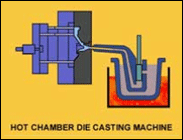- A “multiple-slide” hot chamber die-casting machine has two or more independently movable slides, which carry die blocks and operate within a precision slide guiding system.
- The use of up to four slides is common, and as many as eight slides are possible (six hydraulic and 2 pneumatic)
- Each of the die blocks has one or more cavities and/or cores on its face, which together form the complete cavity and runner profile (into which the molten metal is injected).
- The mating faces of the die blocks are held together by a clamping system.
- Injection of molten metal is made perpendicular to the mating faces of the die blocks, directly on the parting line (“parting line injection”), thereby eliminating the sprue associated with conventional die-casting systems.
The advantages of this technology include:
- Complex part geometry produced with high precision; Consistent part quality;
- Excellent part to part conformity
- Quick die changeovers;
- In-die de-gating and automatic separation of parts from runners is possible in many cases;
- Flash-free castings;
- Rapid cycle speeds;
- Low tooling costs;
- Elimination / reduction of secondary operations;
- Savings in material, energy & labor.
Hot Chamber Machines

Hot chamber machines are used primarily for zinc, copper, magnesium, lead and other low melting point alloys that do not readily attack and erode metal pots, cylinders and plungers. The injection mechanism of a hot chamber machine is immersed in the molten metal bath of a metal holding furnace. The furnace is attached to the machine by a metal feed system called a gooseneck. As the injection cylinder plunger rises, a port in the injection sleeve cylinder opens, allowing molten metal to fill the injection sleeve cylinder. As the plunger moves downward it seals the port and forces molten metal through the gooseneck and nozzle into the die cavity. After the metal has solidified in the die cavity, the plunger is withdrawn, the die opens and the casting is ejected.
